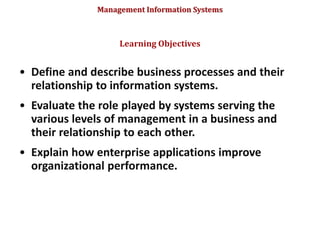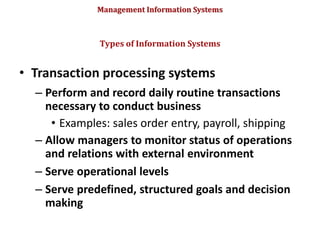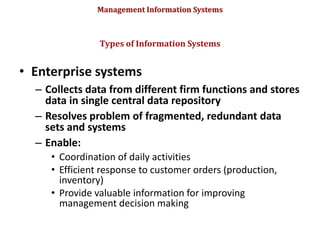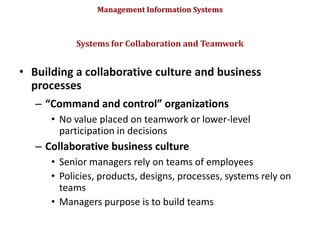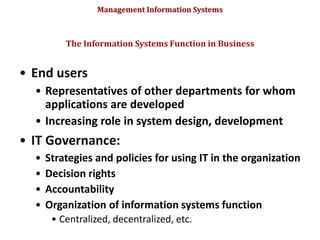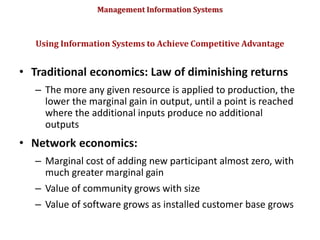3864945.ppt
- 1. Management Information Systems • Understanding the effects of information systems on business and their relationship to globalization. • Explain why information systems are so essential in business today. • Define an information system and describe its management, organization, and technology components. Learning Objectives
- 2. Management Information Systems • Define complementary assets and explain how they ensure that information systems provide genuine value to an organization. • Describe the different academic disciplines used to study information systems and explain how each contributes to our understanding of them. • Explain what is meant by a sociotechnical systems perspective. Learning Objectives (cont.)
- 3. Management Information Systems • How information systems are transforming business – Increase in wireless technology use, Web sites – Increased business use of Web 2.0 technologies – Cloud computing, mobile digital platform allow more distributed work, decision-making, and collaboration • Globalization opportunities – Internet has drastically reduced costs of operating on global scale – Presents both challenges and opportunities The Role of Information Systems in Business Today
- 4. Management Information Systems • In the emerging, fully digital firm – Significant business relationships are digitally enabled and mediated – Core business processes are accomplished through digital networks – Key corporate assets are managed digitally • Digital firms offer greater flexibility in organization and management – Time shifting, space shifting The Role of Information Systems in Business Today
- 5. Management Information Systems • Growing interdependence between ability to use information technology and ability to implement corporate strategies and achieve corporate goals • Business firms invest heavily in information systems to achieve six strategic business objectives: 1. Operational excellence 2. New products, services, and business models 3. Customer and supplier intimacy 4. Improved decision making 5. Competitive advantage 6. Survival The Role of Information Systems in Business Today
- 6. Management Information Systems • Operational excellence: –Improvement of efficiency to attain higher profitability –Information systems, technology an important tool in achieving greater efficiency and productivity –Walmart’s RetailLink system links suppliers to stores for superior replenishment system The Role of Information Systems in Business Today
- 7. Management Information Systems • New products, services, and business models: – Business model: describes how company produces, delivers, and sells product or service to create wealth – Information systems and technology a major enabling tool for new products, services, business models • Examples: Apple’s iPod, iTunes, iPhone, iPad, Google’s Android OS, and Netflix The Role of Information Systems in Business Today
- 8. Management Information Systems • Customer and supplier intimacy: – Serving customers well leads to customers returning, which raises revenues and profits • Example: High-end hotels that use computers to track customer preferences and use to monitor and customize environment – Intimacy with suppliers allows them to provide vital inputs, which lowers costs • Example: J.C.Penney’s information system which links sales records to contract manufacturer The Role of Information Systems in Business Today
- 9. Management Information Systems • Improved decision making – Without accurate information: • Managers must use forecasts, best guesses, luck • Leads to: – Overproduction, underproduction of goods and services – Misallocation of resources – Poor response times • Poor outcomes raise costs, lose customers – Example: Verizon’s Web-based digital dashboard to provide managers with real-time data on customer complaints, network performance, line outages, etc. The Role of Information Systems in Business Today
- 10. Management Information Systems • Operational excellence: – Improvement of efficiency to attain higher profitability • New products, services, and business models: – Enabled by technology • Customer and supplier intimacy: – Serving customers raises revenues and profits – Better communication with suppliers lowers costs • Improved decision making – More accurate data leads to better decisions The Role of Information Systems in Business Today
- 11. Management Information Systems • Competitive advantage – Delivering better performance – Charging less for superior products – Responding to customers and suppliers in real time – Examples: Apple, Walmart, UPS The Role of Information Systems in Business Today
- 12. Management Information Systems • Survival – Information technologies as necessity of business – May be: • Industry-level changes, e.g. Citibank’s introduction of ATMs • Governmental regulations requiring record- keeping – Examples: Toxic Substances Control Act, Sarbanes- Oxley Act The Role of Information Systems in Business Today
- 13. Management Information Systems The Role of Information Systems in Business Today The Interdependence Between Organizations and Information Technology In contemporary systems there is a growing interdependence between a firm’s information systems and its business capabilities. Changes in strategy, rules, and business processes increasingly require changes in hardware, software, databases, and telecommunications. Often, what the organization would like to do depends on what its systems will permit it to do. Figure 1.2
- 14. Management Information Systems • Information system: – Set of interrelated components – Collect, process, store, and distribute information – Support decision making, coordination, and control • Information vs. data – Data are streams of raw facts – Information is data shaped into meaningful form Perspectives on Information Systems
- 15. Management Information Systems Perspectives on Information Systems Data and Information Raw data from a supermarket checkout counter can be processed and organized to produce meaningful information, such as the total unit sales of dish detergent or the total sales revenue from dish detergent for a specific store or sales territory. Figure 1.3
- 16. Management Information Systems • Three activities of information systems produce information organizations need 1. Input: Captures raw data from organization or external environment 2. Processing: Converts raw data into meaningful form 3. Output: Transfers processed information to people or activities that use it Perspectives on Information Systems
- 17. Management Information Systems • Management dimension of information systems – Managers set organizational strategy for responding to business challenges – In addition, managers must act creatively: • Creation of new products and services • Occasionally re-creating the organization Perspectives on Information Systems
- 18. Management Information Systems • Technology dimension of information systems – Computer hardware and software – Data management technology – Networking and telecommunications technology • Networks, the Internet, intranets and extranets, World Wide Web – IT infrastructure: provides platform that system is built on Perspectives on Information Systems
- 19. Management Information Systems • Dimensions of UPS tracking system – Organizational: • Procedures for tracking packages and managing inventory and provide information – Management: • Monitor service levels and costs – Technology: • Handheld computers, bar-code scanners, networks, desktop computers, etc. Perspectives on Information Systems
- 20. Management Information Systems • Business perspective on information systems: – Information system is instrument for creating value – Investments in information technology will result in superior returns: • Productivity increases • Revenue increases • Superior long-term strategic positioning Perspectives on Information Systems
- 21. Management Information Systems • Business information value chain – Raw data acquired and transformed through stages that add value to that information – Value of information system determined in part by extent to which it leads to better decisions, greater efficiency, and higher profits • Business perspective: – Calls attention to organizational and managerial nature of information systems Perspectives on Information Systems
- 22. Management Information Systems • Investing in information technology does not guarantee good returns • Considerable variation in the returns firms receive from systems investments • Factors: – Adopting the right business model – Investing in complementary assets (organizational and management capital) Perspectives on Information Systems
- 23. Management Information Systems • Complementary assets: –Assets required to derive value from a primary investment –Firms supporting technology investments with investment in complementary assets receive superior returns –E.g.: invest in technology and the people to make it work properly Perspectives on Information Systems
- 24. Management Information Systems • Complementary assets include: – Organizational assets, e.g. • Appropriate business model • Efficient business processes – Managerial assets, e.g. • Incentives for management innovation • Teamwork and collaborative work environments – Social assets, e.g. • The Internet and telecommunications infrastructure • Technology standards Perspectives on Information Systems
- 25. Management Information Systems • Technical approach – Emphasizes mathematically based models – Computer science, management science, operations research • Behavioral approach – Behavioral issues (strategic business integration, implementation, etc.) – Psychology, economics, sociology Contemporary Approaches to Information Systems
- 26. Management Information Systems • Management Information Systems – Combines computer science, management science, operations research and practical orientation with behavioral issues • Four main actors – Suppliers of hardware and software – Business firms – Managers and employees – Firm’s environment (legal, social, cultural context) Contemporary Approaches to Information Systems
- 27. Management Information Systems • Define and describe business processes and their relationship to information systems. • Evaluate the role played by systems serving the various levels of management in a business and their relationship to each other. • Explain how enterprise applications improve organizational performance. Learning Objectives © Prentice Hall 2011 27
- 28. Management Information Systems • Explain the importance of collaboration and teamwork in business and how they are supported by technology. • Assess the role of the information systems function in a business. Learning Objectives (cont.) © Prentice Hall 2011 28
- 29. Management Information Systems • Business processes: – Workflows of material, information, knowledge – Sets of activities, steps – May be tied to functional area or be cross- functional • Businesses: Can be seen as collection of business processes • Business processes may be assets or liabilities Business Processes and Information Systems © Prentice Hall 2011 29
- 30. Management Information Systems • Examples of functional business processes – Manufacturing and production • Assembling the product – Sales and marketing • Identifying customers – Finance and accounting • Creating financial statements – Human resources • Hiring employees Business Processes and Information Systems © Prentice Hall 2011 30
- 31. Management Information Systems • Information technology enhances business processes in two main ways: 1. Increasing efficiency of existing processes • Automating steps that were manual 2. Enabling entirely new processes that are capable of transforming the businesses • Change flow of information • Replace sequential steps with parallel steps • Eliminate delays in decision making Business Processes and Information Systems © Prentice Hall 2011 31
- 32. Management Information Systems • Transaction processing systems – Perform and record daily routine transactions necessary to conduct business • Examples: sales order entry, payroll, shipping – Allow managers to monitor status of operations and relations with external environment – Serve operational levels – Serve predefined, structured goals and decision making Types of Information Systems © Prentice Hall 2011 32
- 33. Management Information Systems • Management information systems –Serve middle management –Provide reports on firm’s current performance, based on data from TPS –Provide answers to routine questions with predefined procedure for answering them –Typically have little analytic capability Types of Information Systems © Prentice Hall 2011 33
- 34. Management Information Systems • Decision support systems – Serve middle management – Support non-routine decision making • Example: What is impact on production schedule if December sales doubled? – Often use external information as well from TPS and MIS – Model driven DSS • Voyage-estimating systems – Data driven DSS • Intrawest’s marketing analysis systems Types of Information Systems © Prentice Hall 2011 34
- 35. Management Information Systems • Business intelligence – Class of software applications – Analyze current and historical data to find patterns and trends and aid decision-making – Used in systems that support middle and senior management • Data-driven DSS • Executive support systems (ESS) Types of Information Systems © Prentice Hall 2011 35
- 36. Management Information Systems • Executive support systems – Support senior management – Address non-routine decisions • Requiring judgment, evaluation, and insight – Incorporate data about external events (e.g. new tax laws or competitors) as well as summarized information from internal MIS and DSS – Example: Digital dashboard with real-time view of firm’s financial performance: working capital, accounts receivable, accounts payable, cash flow, and inventory Types of Information Systems © Prentice Hall 2011 36
- 37. Management Information Systems • Systems from a constituency perspective –Transaction processing systems: supporting operational level employees –Management information systems and decision-support systems: supporting managers –Executive support systems: supporting executives Types of Information Systems © Prentice Hall 2011 37
- 38. Management Information Systems • Relationship of systems to one another –TPS: Major source of data for other systems –ESS: Recipient of data from lower-level systems –Data may be exchanged between systems –In reality, most businesses’ systems are only loosely integrated (but they are getting better!) Types of Information Systems © Prentice Hall 2011 38
- 39. Management Information Systems • Enterprise applications – Systems for linking the enterprise – Span functional areas – Execute business processes across firm – Include all levels of management – Four major applications: • Enterprise systems • Supply chain management systems • Customer relationship management systems • Knowledge management systems Types of Information Systems © Prentice Hall 2011 39
- 40. Management Information Systems • Enterprise systems – Collects data from different firm functions and stores data in single central data repository – Resolves problem of fragmented, redundant data sets and systems – Enable: • Coordination of daily activities • Efficient response to customer orders (production, inventory) • Provide valuable information for improving management decision making Types of Information Systems © Prentice Hall 2011 40
- 41. Management Information Systems • Supply chain management (SCM) systems –Manage firm’s relationships with suppliers –Share information about • Orders, production, inventory levels, delivery of products and services –Goal: • Right amount of products to destination with least amount of time and lowest cost Types of Information Systems © Prentice Hall 2011 41
- 42. Management Information Systems • Customer relationship management systems: – Provide information to coordinate all of the business processes that deal with customers in sales, marketing, and service to optimize revenue, customer satisfaction, and customer retention – Integrate firm’s customer-related processes and consolidate customer information from multiple communication channels Types of Information Systems © Prentice Hall 2011 42
- 43. Management Information Systems • Knowledge management systems (KMS) – Support processes for acquiring, creating, storing, distributing, applying, integrating knowledge • How to create, produce, distribute products and services – Collect internal knowledge and experience within firm and make it available to employees – Link to external sources of knowledge Types of Information Systems © Prentice Hall 2011 43
- 44. Management Information Systems • Alternative tools that increase integration and expedite the flow of information – Intranets: • Internal company Web sites accessible only by employees – Extranets: • Company Web sites accessible externally only to vendors and suppliers • Often used to coordinate supply chain Types of Information Systems © Prentice Hall 2011 44
- 45. Management Information Systems • E-business – Use of digital technology and Internet to drive major business processes • E-commerce – Subset of e-business – Buying and selling goods and services through Internet • E-government: – Using Internet technology to deliver information and services to citizens, employees, and businesses Types of Information Systems © Prentice Hall 2011 45
- 46. Management Information Systems • Collaboration: – Short-lived or long-term – Informal or formal (teams) • Growing importance of collaboration: – Changing nature of work – Growth of professional work – “interaction jobs” – Changing organization of the firm – Changing scope of the firm – Emphasis on innovation – Changing culture of work Systems for Collaboration and Teamwork © Prentice Hall 2011 46
- 47. Management Information Systems • Business benefits of collaboration and teamwork – Investments in collaboration technology can produce organizational improvements returning high ROI – Benefits: • Productivity • Quality • Innovation • Customer service • Financial performance – Profitability, sales, sales growth Systems for Collaboration and Teamwork © Prentice Hall 2011 47
- 48. Management Information Systems • Building a collaborative culture and business processes – “Command and control” organizations • No value placed on teamwork or lower-level participation in decisions – Collaborative business culture • Senior managers rely on teams of employees • Policies, products, designs, processes, systems rely on teams • Managers purpose is to build teams Systems for Collaboration and Teamwork © Prentice Hall 2011 48
- 49. Management Information Systems • Technology for collaboration and teamwork – 15 categories of collaborative software tools Email and instant messaging White boarding Collaborative writing Web presenting Collaborative reviewing Work scheduling Event scheduling Document sharing /wikis File sharing Mind mapping Screen sharingLarge audience Webinars Audio conferencing Co-browsing Video conferencing Systems for Collaboration and Teamwork © Prentice Hall 2011 49
- 50. Management Information Systems • Technology for collaboration and teamwork (cont.) – Social Networking – Wikis – Virtual Worlds – Internet-Based Collaboration Environments • Virtual meeting systems (telepresence) • Google Apps/Google sites • Microsoft SharePoint • Lotus Notes Systems for Collaboration and Teamwork © Prentice Hall 2011 50
- 51. Management Information Systems • Two dimensions of collaboration technologies – Space (or location) – remote or colocated – Time – synchronous or asynchronous • Six steps in evaluating software tools 1. What are your firm’s collaboration challenges? 2. What kinds of solutions are available? 3. Analyze available products’ cost and benefits 4. Evaluate security risks 5. Consult users for implementation and training issues 6. Evaluate product vendors Systems for Collaboration and Teamwork © Prentice Hall 2011 51
- 52. Management Information Systems • Information systems department: • Formal organizational unit responsible for information technology services • Often headed by chief information officer (CIO) • Other senior positions include chief security officer (CSO), chief knowledge officer (CKO), chief privacy officer (CPO) • Programmers • Systems analysts • Information systems managers The Information Systems Function in Business © Prentice Hall 2011 52
- 53. Management Information Systems • End users • Representatives of other departments for whom applications are developed • Increasing role in system design, development • IT Governance: • Strategies and policies for using IT in the organization • Decision rights • Accountability • Organization of information systems function • Centralized, decentralized, etc. The Information Systems Function in Business © Prentice Hall 2011 53
- 54. Management Information Systems • Identify and describe important features of organizations that managers need to know about in order to build and use information systems successfully. • Demonstrate how Porter’s competitive forces model helps companies develop competitive strategies using information systems. • Explain how the value chain and value web models help businesses identify opportunities for strategic information system applications. Learning Objectives © Prentice Hall 2011 54
- 55. Management Information Systems • Demonstrate how information systems help businesses use synergies, core competencies, and network-based strategies to achieve competitive advantage. • Assess the challenges posed by strategic information systems and management solutions. Learning Objectives (cont.) © Prentice Hall 2011 55
- 56. Management Information Systems • Information technology and organizations influence one another – Complex relationship influenced by organization’s • Structure • Business processes • Politics • Culture • Environment, and • Management decisions Organizations and Information Systems © Prentice Hall 2011 56
- 57. Management Information Systems • What is an organization? – Technical definition: • Stable, formal social structure that takes resources from environment and processes them to produce outputs • A formal legal entity with internal rules and procedures, as well as a social structure – Behavioral definition: • A collection of rights, privileges, obligations, and responsibilities that is delicately balanced over a period of time through conflict and conflict resolution Organizations and Information Systems © Prentice Hall 2011 57
- 58. Management Information Systems • Features of organizations •Use of hierarchical structure •Accountability, authority in system of impartial decision making •Adherence to principle of efficiency •Routines and business processes •Organizational politics, culture, environments and structures Organizations and Information Systems © Prentice Hall 2011 58
- 59. Management Information Systems • Routines and business processes • Routines (standard operating procedures) •Precise rules, procedures, and practices developed to cope with virtually all expected situations • Business processes: Collections of routines • Business firm: Collection of business processes Organizations and Information Systems © Prentice Hall 2011 59
- 60. Management Information Systems • Organizational politics •Divergent viewpoints lead to political struggle, competition, and conflict •Political resistance greatly hampers organizational change Organizations and Information Systems © Prentice Hall 2011 60
- 61. Management Information Systems • Organizational culture: • Encompasses set of assumptions that define goal and product •What products the organization should produce •How and where it should be produced •For whom the products should be produced • May be powerful unifying force as well as restraint on change Organizations and Information Systems © Prentice Hall 2011 61
- 62. Management Information Systems • Organizational environments: • Organizations and environments have a reciprocal relationship • Organizations are open to, and dependent on, the social and physical environment • Organizations can influence their environments • Environments generally change faster than organizations • Information systems can be an instrument of environmental scanning, act as a lens Organizations and Information Systems © Prentice Hall 2011 62
- 63. Management Information Systems • Disruptive technologies – Technology that brings about sweeping change to businesses, industries, markets – Examples: personal computers, word processing software, the Internet, the PageRank algorithm – First movers and fast followers • First movers – inventors of disruptive technologies • Fast followers – firms with the size and resources to capitalize on that technology Organizations and Information Systems © Prentice Hall 2011 63
- 64. Management Information Systems • 5 basic kinds of organizational structure – Entrepreneurial: • Small start-up business – Machine bureaucracy: • Midsize manufacturing firm – Divisionalized bureaucracy: • Fortune 500 firms – Professional bureaucracy: • Law firms, school systems, hospitals – Adhocracy: • Consulting firms Organizations and Information Systems © Prentice Hall 2011 64
- 65. Management Information Systems • Other organizational features –Goals –Constituencies –Leadership styles –Tasks –Surrounding environments Organizations and Information Systems © Prentice Hall 2011 65
- 66. Management Information Systems • Economic impacts – IT changes relative costs of capital and the costs of information – Information systems technology is a factor of production, like capital and labor – IT affects the cost and quality of information and changes economics of information • Information technology helps firms contract in size because it can reduce transaction costs (the cost of participating in markets) – Outsourcing How Information Systems Impact Organizations and Business Firms © Prentice Hall 2011 66
- 67. Management Information Systems • Transaction cost theory – Firms seek to economize on transaction costs (the costs of participating in markets) • Vertical integration, hiring more employees, buying suppliers and distributors – IT lowers market transaction costs for a firm, making it worthwhile for firms to transact with other firms rather than grow the number of employees How Information Systems Impact Organizations and Business Firms © Prentice Hall 2011 67
- 68. Management Information Systems • Agency theory: – Firm is nexus of contracts among self-interested parties requiring supervision – Firms experience agency costs (the cost of managing and supervising) which rise as firm grows – IT can reduce agency costs, making it possible for firms to grow without adding to the costs of supervising, and without adding employees How Information Systems Impact Organizations and Business Firms © Prentice Hall 2011 68
- 69. Management Information Systems • Organizational and behavioral impacts – IT flattens organizations • Decision making pushed to lower levels • Fewer managers needed (IT enables faster decision making and increases span of control) – Postindustrial organizations • Organizations flatten because in postindustrial societies, authority increasingly relies on knowledge and competence rather than formal positions How Information Systems Impact Organizations and Business Firms © Prentice Hall 2011 69
- 70. Management Information Systems • Organizational resistance to change – Information systems become bound up in organizational politics because they influence access to a key resource – information – Information systems potentially change an organization’s structure, culture, politics, and work – Most common reason for failure of large projects is due to organizational and political resistance to change How Information Systems Impact Organizations and Business Firms © Prentice Hall 2011 70
- 71. Management Information Systems • The Internet and organizations – The Internet increases the accessibility, storage, and distribution of information and knowledge for organizations – The Internet can greatly lower transaction and agency costs • Example: Large firm delivers internal manuals to employees via a corporate Web site, saving millions of dollars in distribution costs How Information Systems Impact Organizations and Business Firms © Prentice Hall 2011 71
- 72. Management Information Systems • Central organizational factors to consider when planning a new system: – Environment – Structure • Hierarchy, specialization, routines, business processes – Culture and politics – Type of organization and style of leadership – Main interest groups affected by system; attitudes of end users – Tasks, decisions, and business processes the system will assist How Information Systems Impact Organizations and Business Firms © Prentice Hall 2011 72
- 73. Management Information Systems • Why do some firms become leaders in their industry? • Michael Porter’s competitive forces model – Provides general view of firm, its competitors, and environment – Five competitive forces shape fate of firm 1. Traditional competitors 2. New market entrants 3. Substitute products and services 4. Customers 5. Suppliers Using Information Systems to Achieve Competitive Advantage © Prentice Hall 2011 73
- 74. Management Information Systems • Traditional competitors – All firms share market space with competitors who are continuously devising new products, services, efficiencies, switching costs • New market entrants – Some industries have high barriers to entry, e.g. computer chip business – New companies have new equipment, younger workers, but little brand recognition Using Information Systems to Achieve Competitive Advantage © Prentice Hall 2011 74
- 75. Management Information Systems • Substitute products and services – Substitutes customers might use if your prices become too high, e.g. iTunes substitutes for CDs • Customers – Can customers easily switch to competitor’s products? Can they force businesses to compete on price alone in transparent marketplace? • Suppliers – Market power of suppliers when firm cannot raise prices as fast as suppliers Using Information Systems to Achieve Competitive Advantage © Prentice Hall 2011 75
- 76. Management Information Systems • Four generic strategies for dealing with competitive forces, enabled by using IT –Low-cost leadership –Product differentiation –Focus on market niche –Strengthen customer and supplier intimacy Using Information Systems to Achieve Competitive Advantage © Prentice Hall 2011 76
- 77. Management Information Systems • Low-cost leadership – Produce products and services at a lower price than competitors while enhancing quality and level of service – Examples: Wal-Mart • Product differentiation – Enable new products or services, greatly change customer convenience and experience – Examples: Google, Nike, Apple Using Information Systems to Achieve Competitive Advantage © Prentice Hall 2011 77
- 78. Management Information Systems • Focus on market niche – Use information systems to enable a focused strategy on a single market niche; specialize – Example: Hilton Hotels • Strengthen customer and supplier intimacy – Use information systems to develop strong ties and loyalty with customers and suppliers; increase switching costs – Example: Netflix, Amazon Using Information Systems to Achieve Competitive Advantage © Prentice Hall 2011 78
- 79. Management Information Systems • The Internet’s impact on competitive advantage – Transformation, destruction, threat to some industries • E.g. travel agency, printed encyclopedia, newspaper – Competitive forces still at work, but rivalry more intense – Universal standards allow new rivals, entrants to market – New opportunities for building brands and loyal customer bases Using Information Systems to Achieve Competitive Advantage © Prentice Hall 2011 79
- 80. Management Information Systems • Business value chain model – Views firm as series of activities that add value to products or services – Highlights activities where competitive strategies can best be applied • Primary activities vs. support activities – At each stage, determine how information systems can improve operational efficiency and improve customer and supplier intimacy – Utilize benchmarking, industry best practices Using Information Systems to Achieve Competitive Advantage © Prentice Hall 2011 80
- 81. Management Information Systems • Value web: –Collection of independent firms using highly synchronized IT to coordinate value chains to produce product or service collectively –More customer driven, less linear operation than traditional value chain Using Information Systems to Achieve Competitive Advantage © Prentice Hall 2011 81
- 82. Management Information Systems • Information systems can improve overall performance of business units by promoting synergies and core competencies – Synergies • When output of some units used as inputs to others, or organizations pool markets and expertise • Example: merger of Bank of NY and JPMorgan Chase • Purchase of YouTube by Google Using Information Systems to Achieve Competitive Advantage © Prentice Hall 2011 82
- 83. Management Information Systems • Core competencies –Activity for which firm is world-class leader –Relies on knowledge, experience, and sharing this across business units –Example: Procter & Gamble’s intranet and directory of subject matter experts Using Information Systems to Achieve Competitive Advantage © Prentice Hall 2011 83
- 84. Management Information Systems • Network-based strategies –Take advantage of firm’s abilities to network with each other –Include use of: • Network economics • Virtual company model • Business ecosystems Using Information Systems to Achieve Competitive Advantage © Prentice Hall 2011 84
- 85. Management Information Systems • Traditional economics: Law of diminishing returns – The more any given resource is applied to production, the lower the marginal gain in output, until a point is reached where the additional inputs produce no additional outputs • Network economics: – Marginal cost of adding new participant almost zero, with much greater marginal gain – Value of community grows with size – Value of software grows as installed customer base grows Using Information Systems to Achieve Competitive Advantage © Prentice Hall 2011 85
- 86. Management Information Systems • Virtual company strategy – Virtual company uses networks to ally with other companies to create and distribute products without being limited by traditional organizational boundaries or physical locations – E.g. Li & Fung manages production, shipment of garments for major fashion companies, outsourcing all work to over 7,500 suppliers Using Information Systems to Achieve Competitive Advantage © Prentice Hall 2011 86
- 87. Management Information Systems • Business ecosystems – Industry sets of firms providing related services and products • Microsoft platform used by thousands of firms • Wal-Mart’s order entry and inventory management – Keystone firms: Dominate ecosystem and create platform used by other firms – Niche firms: Rely on platform developed by keystone firm – Individual firms can consider how IT will help them become profitable niche players in larger ecosystems Using Information Systems to Achieve Competitive Advantage © Prentice Hall 2011 87
- 88. Management Information Systems • Sustaining competitive advantage – Because competitors can retaliate and copy strategic systems, competitive advantage is not always sustainable; systems may become tools for survival • Performing strategic systems analysis – What is structure of industry? – What are value chains for this firm? • Managing strategic transitions – Adopting strategic systems requires changes in business goals, relationships with customers and suppliers, and business processes Using Information Systems for Competitive Advantage: Management Issues © Prentice Hall 2011 88


























